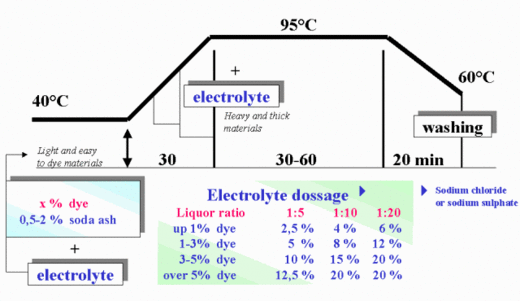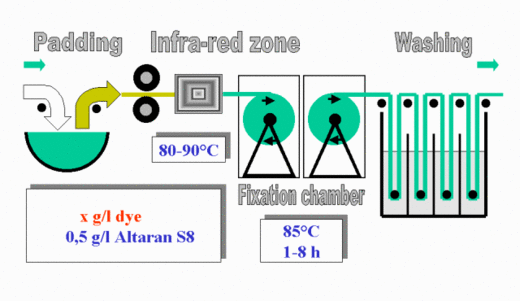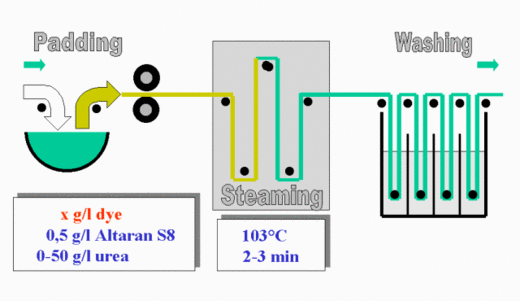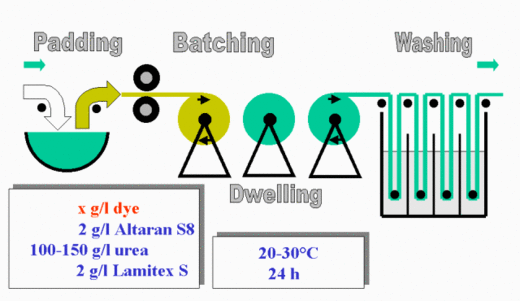dyes.synthesia.eu / Organic dyes / Textile dyes / SATURN BLUE LFG 135
SATURN BLUE LFG 135
|
Illustration on cotton |
||
|
0,50 % |
0,75 % |
|
| Characteristic | |
| C. I. | Direct Blue 85 |
| CAS No. | 70210-31-0 |
| Chemical Class |
Azodye |
| Properties | |
| Solubility (g/l at 90°C) | 20 |
| Dischargeability neutral/alkaline | 4-5/4-5 |
| Coverage dead cotton | + |
| Coverage strippy viscose | - |
| Dyeing at 120°C (30/60 min) | +/- |
| Fastness | cotton | viscose | ||||||||
| standard depth | 1/12 | 1/6 | 1/3 | 1/1 | 2/1 | 1/12 | 1/6 | 1/3 | 1/1 | 2/1 |
| Daylight | 3-4 | 4 | 5 | 6 | 6-7 | 5 | 5-6 | 6 | 7 | 7-8 |
| Light-Xenotest | 3-4 | 4 | 5 | 6 | 6-7 | 5 | 5-6 | 6 | 7 | 7-8 |
| standard depth 1/1 | aftertreated | untreated | aftertreated | untreated | ||||||||
| Water | 4-5 | 4-5 | 5 | 4-5 | 2 | 3 | 4-5 | 4 | 5 | 4 | 2 | 3 |
| Washing 40°C | 3-4GBr | 3 | 5 | 3G | 2-3 | 5 | 3-4 | 5 | 5 | 3-4G | 4-5 | 5 |
| Washing 60°C | 3G | 2 | 4-5 | 2-3G | 1-2 | 4 | 3 | 4 | 4-5 | 3G | 3 | 4-5 |
| Domestic laundering A1S | 4 | 3-4 | 4-5 | 3-4 | 1 | 4-5 | 4 | 4 | 4-5 | 3-4 | 1-2 | 4-5 |
| Perspiration acid | 4-5 | 3-4 | 5 | 3GBr | 1-2 | 3 | 3-4G | 4 | 4-5 | 4G | 3 | 4 |
| Perspiration alkaline | 4-5 | 4 | 5 | 3-4GBr | 2 | 3 | 4-5 | 4 | 4-5 | 4G | 3 | 4 |
| Exhaustion curves |
| Temperature effect |
|
|
| Influence of electrolyte |
|
|
| Application possibilities |
Exhaustion dyeing 
|
|
|
Pad - Jig 
|
|
|
Pad - Roll 
|
|
|
Pad - Steam 
|
|
|
Pad - Batch 
|
|
|
 suitable suitable  partially suitable partially suitable  unsuitable unsuitable
|
| Testing methods | ||||||||||||||||||||||||||||||||||||||||||||||||||||||
|
Solubility
Dischargeability
Dead and unripe cotton covering
Stripy viscose covering
Dyeing at temperatures above 100°C. Fastness standards
Affinity dependance on the temperature
Electrolyte influence |
||||||||||||||||||||||||||||||||||||||||||||||||||||||
Notice of change of shareholder of Synthesia, a.s.
PF 2024
Synthesia received the AAA Platinum Excellence Award







